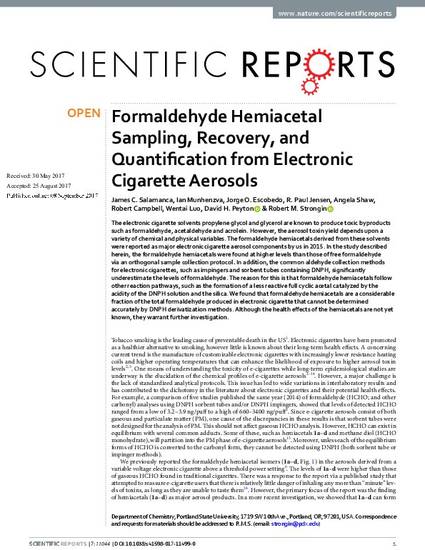
- Electronic cigarettes -- Composition -- Analysis,
- Formaldehyde,
- Commercial products -- Testing,
- Toxological chemistry,
- Tobacco products -- Additives,
- Tobacco products -- Chemistry
The electronic cigarette solvents propylene glycol and glycerol are known to produce toxic byproducts such as formaldehyde, acetaldehyde and acrolein. However, the aerosol toxin yield depends upon a variety of chemical and physical variables. The formaldehyde hemiacetals derived from these solvents were reported as major electronic cigarette aerosol components by us in 2015. In the study described herein, the formaldehyde hemiacetals were found at higher levels than those of free formaldehyde via an orthogonal sample collection protocol. In addition, the common aldehyde collection methods for electronic cigarettes, such as impingers and sorbent tubes containing DNPH, significantly underestimate the levels of formaldehyde. The reason for this is that formaldehyde hemiacetals follow other reaction pathways, such as the formation of a less reactive full cyclic acetal catalyzed by the acidity of the DNPH solution and the silica. We found that formaldehyde hemiacetals are a considerable fraction of the total formaldehyde produced in electronic cigarette that cannot be determined accurately by DNPH derivatization methods. Although the health effects of the hemiacetals are not yet known, they warrant further investigation.

Open Access This article is licensed under a Creative Commons Attribution 4.0 International License, which permits use, sharing, adaptation, distribution and reproduction in any medium or format, as long as you give appropriate credit to the original author(s) and the source, provide a link to the Creative Commons license, and indicate if changes were made. The images or other third party material in this article are included in the article’s Creative Commons license, unless indicated otherwise in a credit line to the material. If material is not included in the article’s Creative Commons license and your intended use is not permitted by statutory regulation or exceeds the permitted use, you will need to obtain permission directly from the copyright holder. To view a copy of this license, visit http://creativecommons.org/licenses/by/4.0/. © The Author(s) 2017